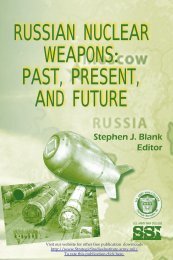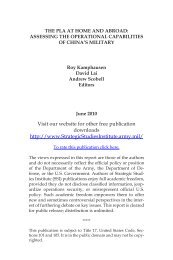The United States and China in Power Transition - Strategic Studies ...
The United States and China in Power Transition - Strategic Studies ...
The United States and China in Power Transition - Strategic Studies ...
You also want an ePaper? Increase the reach of your titles
YUMPU automatically turns print PDFs into web optimized ePapers that Google loves.
complicate the Tibet problem <strong>and</strong> loosen up the Tibetans-<strong>in</strong>-exile<br />
to pursue their course with resort to violent<br />
means. Zhu Weiqun said that <strong>Ch<strong>in</strong>a</strong> would not be<br />
afraid to meet force with force if the Tibetans were to<br />
turn violent. As Zhu put it, “we have fought before;<br />
you should remember your defeats <strong>in</strong> the past; <strong>and</strong><br />
there is no chance for you <strong>in</strong> the future.” 191 This future,<br />
accord<strong>in</strong>g to Wang Lixiong (王力雄), a noted Ch<strong>in</strong>ese<br />
dissident writer <strong>and</strong> self-made Tibetan observer, for<br />
the Tibetans as well as the Ch<strong>in</strong>ese, is doomed. 192<br />
X<strong>in</strong>jiang, <strong>Ch<strong>in</strong>a</strong>, <strong>and</strong> the <strong>United</strong> <strong>States</strong>. In many<br />
ways, X<strong>in</strong>jiang is more complicated <strong>and</strong> explosive<br />
than Tibet. Unlike the homogenous Tibet, X<strong>in</strong>jiang<br />
has many different ethnic groups long<strong>in</strong>g for different<br />
futures. While the Tibetans have the Dalai Lama<br />
as a religious leader preach<strong>in</strong>g for nonviolent ways to<br />
pursue their goals, the ethnic groups <strong>in</strong> X<strong>in</strong>jiang are<br />
fragmented <strong>and</strong> have no commonly-accepted leaders.<br />
Worse, many <strong>in</strong> X<strong>in</strong>jiang are <strong>in</strong>fluenced by their<br />
radical <strong>and</strong> extremist Muslim brethren <strong>in</strong> the troubled<br />
areas of Central Asia <strong>and</strong> the Middle East, <strong>and</strong> look to<br />
their experience for answers to the X<strong>in</strong>jiang problem.<br />
What is the X<strong>in</strong>jiang problem? It is about the fate<br />
of a piece of l<strong>and</strong> <strong>in</strong> the very center of Asia known <strong>in</strong><br />
Ch<strong>in</strong>ese as the “Western <strong>and</strong> New Territory” (西域新<br />
疆) or <strong>in</strong> Uyghur separatist terms, “East Turkistan.” 193<br />
<strong>The</strong> issue is whether it should stay as an “<strong>in</strong>tr<strong>in</strong>sic <strong>and</strong><br />
<strong>in</strong>separable part of <strong>Ch<strong>in</strong>a</strong>,” or become an <strong>in</strong>dependent<br />
homel<strong>and</strong> for the Uyghur people, or to be partitioned<br />
along ethnic l<strong>in</strong>es to accommodate the <strong>in</strong>terests of the<br />
East Turkic ethnic groups <strong>and</strong> the Han Ch<strong>in</strong>ese.<br />
<strong>The</strong> X<strong>in</strong>jiang problem has a long history. <strong>The</strong> Ch<strong>in</strong>ese<br />
claim of this l<strong>and</strong>, for <strong>in</strong>stance, goes back to dynastic<br />
<strong>Ch<strong>in</strong>a</strong>’s Western Han era of 200 BC. Over the<br />
ages, there have been changes of possession among<br />
168

















